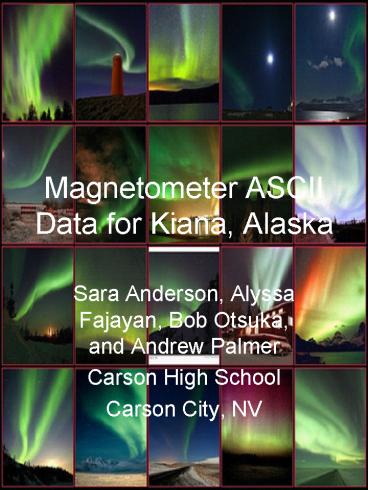Magnetometer ASCII Data for Kiana, Alaska PowerPoint PPT Presentation
1 / 21
Title: Magnetometer ASCII Data for Kiana, Alaska
1
Magnetometer ASCII Data for Kiana, Alaska
- Sara Anderson, Alyssa Fajayan, Bob Otsuka, and
Andrew Palmer - Carson High School
- Carson City, NV
2
Location
- Kiana, Alaska.
- Latitude 66.975.
- Longitude -160.423.
- The elevation is 95 feet.
3
How to Collect ASCII Data!
- Go to http//themis.ssl.berkeley.edu/EPO_Access/
- Select your city and the dates you want data for.
- Wait for the data to download
- Your downloaded data has four columns. The first
is the time beginning at .408 sec. after midnight
and the last is 86,399.91 sec. after midnight or
.09 sec. before the next midnight. - The next three columns are the x, y, and z
magnetic field intensities.
4
Analyzing the ASCII Data.
- In order to calculate the K value or the
intensity of the magnetic distortion you first
must find the range in your x component or ?x. By
subtracting the x min from your x max. - After you have found this you can compare this to
the table to evaluate the K value.
5
(No Transcript)
6
Sample ASCII Data
Z component
X component
Y component
Time
7
B-field Information
X Component
Y Component
Z Component
- This diagram shows the set-up of the b-field. In
our data, we are measuring disturbances in the X
component of the B-field.
8
CME (Coronal Mass Ejections)
- Coronal mass ejections are huge magnetic bubbles
of plasma that erupt from the Sun's corona and
travel through space at high speeds toward the
Earth. When these CMEs reach the Earth, they
cause disturbances in the X component of the
magnetic field and in turn, they cause auroras.
9
Data averages for the months of June, July,
August, and September.
10
Data that supports geomagnetic storms. (kmax gt 4)
- On the following dates, we have data that
supports evidence of geomagnetic storms.
Geomagnetic storms are a large disturbance in the
X component of the B-field and they cause
auroras. - JUNE 5,6,7,8,14,15,16,17,18,20,21,25,26,27,28,29,
30 - JULY 1,4,5,11,12,13,14,15,17,18,21,22,23,24,25,26
,27,28 - AUGUST 5,9,10,11,12,14,17,18,19,21,22
- SEPTEMBER 14,15,16,18,19,24,28,29
11
Numerical Data
- Yellow represents Days Where the K value was
Larger than 5. The significance of which means
that there was a Geomagnetic storm.
12
(No Transcript)
13
(No Transcript)
14
15
Spectrograph of a typical day or a day without a
geomagnetic storm 9/13/08
16
Spectrograph of a day with a storm
9/15/08
17
- Kmax Comparisons
- Our Calculated K
- Vs
- Planetary K
18
(No Transcript)
19
(No Transcript)
20
(No Transcript)
21
Conclusion
- Magnetometer data was collected for Kiana, AK
- Earths magnetic field (B-field) has an x, y, and
z component - Disturbances in the x component were measured.
- Coronal mass ejections (CMEs) are bursts of
plasma that erupt from the suns corona, and
travel at high speeds through space - These are responsible for auroras.
- These also cause the Geomagnetic storms that we
recorded data for by causing the charged
particles to interact with the magnetic field,
which in turn causes detectable aberrations in
the magnetic field - When a disturbance of 4 or greater was found in
the x component was found, there is evidence to
support a geomagnetic storm has occurred.

